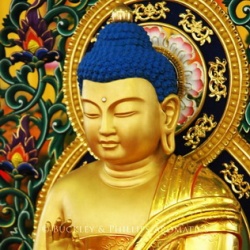Three Inner Tantras
Maha Yoga (Development Stage)
Three Inner Tantras (nang rgyud sde gsum). Mahayoga, Anu Yoga, and Ati Yoga. These three sections of tantra are the special characteristics of the Nyingma School of the Early Translations. According to Jamgön Kongtrül the First, "The Three Inner Tantras are also known as the 'Vehicles of the Methods of Mastery' because they establish the way to experience that the world and beings are the nature of mind manifest as kayas and wisdoms, that everything is the 'indivisibility of the superior two truths,' and hereby ensuring that the practitioner will become adept in the method of gaining mastery over all phenomena as being great equality." The Three Inner Tantras are, respectively, also renowned as 'development, completion, and great perfection' or as 'tantras, statements, and instructions.'
According to Mipham Rinpoche, the Three Inner Tantras reached Tibet through six different lines of transmission:
1) As perceived by ordinary people in Tibet, Padmakara, the Second Buddha, taught only the Instruction on the Garland of Views but bestowed both the profound and extensive empowerments and instructions of all of the Three Inner Tantras to his exceptional disciples including Sangye Yeshe, Rinchen Chok, Lui Wangpo of Khön, and many others, the oral lineages of which have continued unbroken until this very day. Moreover, the major part of his teachings were sealed as terma treasures for the benefit of followers in future generations.
2) When the great translator Vairotsana extensively had received the profound teachings of the Great Perfection from the Twenty-five Panditas, especially from Shri Singha, he returned to Tibet and imparted the Mind Section five times, as well as the oral lineage of the Space Section, both of which are continued uninterruptedly.
3) The great pandita Vimalamitra arrived in Tibet and taught the Instruction Section chiefly to Tingdzin Sangpo of Nyang. This lineage was transmitted both orally and through terma treasures.
4) Sangye Yeshe of Nub received from four masters in India, Nepal and Drusha innumerable teachings headed by the important scriptures of Anu Yoga and Yamantaka. His lineage of the Scripture of the Embodiment of the Realization of All Buddhas is still unbroken.
5) Namkhai Nyingpo received the transmission of the teachings of Vishuddha from the Indian master Hungkara which he then spread in Tibet.
6) During following generations, incarnations of the king and the close disciples of Padmasambhava have, and still continue to do so, successively appeared, as great masters who at opportune times reveal the profound teachings that had been concealed as terma treasures, in order to ensure the supreme welfare of people in Tibet and all other countries, both temporarily and ultimately.
(From the glossary to The Lotus-Born, the biography of Padmasambhava.)
The process is a gradual progression. It is developed through the Shravakayana, Pratyeckabudda, Bodhisattvayana and the three outer tantras. Sometimes known as the Father Tantra, Mahayoga is the generative phase of visualising the deity as being luminosity inseparable from great emptiness. By adopting all those outer expressions of the Vajrayana, a wrathful or semi wrathful male deity associated with the transformation of ego, such as those we see in Vajrayana iconography, we cut through our basic duality of good and bad, our basic sense of ego-centered, discriminating mind.
This is to realise the inseparability of phenomena and great emptiness. The skilful means to attain the inseparability of emptiness and form is to envision everything as the pure mandala of the deities. This is the relative truth.
Meditation
First we visualize the great space of emptiness, which is the fundamentally pure nature of our mind, our basic stream of consciousness. Within this space, we visualize a lotus seat, which symbolizes our pure stream of being. On this lotus seat, we visualize a sun disk and a moon disk, which symbolize the two reproductive cells from the father and mother. On the moon disk, we visualize a luminous, flickering seed syllable, which symbolizes our bardo consciousness. The flickering seed syllable begins to radiate light, which streams out into space and then returns, dissolving into the syllable, before radiating out again, over and over. The process of the light radiating out and returning represents a process of conception. Through this conception, our consciousness transforms from the flickering seed syllable into a Vajrayana deity- Vajrasattva. Thus, we transform ourselves into Vajrasattva, and are born into that realm. At that very moment, we cut directly through all our ego-clinging and emotional conflicts by simply taking birth in this pure world.
Action
When we enter into a this stage we can completely abandon all conceptual clinging. Pure and impure are not differentiated and the five meats and five nectars are accepted without judgement.
Fruit
The state of the mandalas of the five, one hundred, one thousand or countless families is attained in this lifetime or the bardo after death.
Anu Yoga (Perfection Stage)
It is called Anu yoga because anu means "after," or "that which comes after" yoga. After we have developed our visualization of the deity through the Maha yoga practices, we have to dissolve it. The dissolving aspect of the visualization process is the practice of the primordial mind of luminosity. The dissolving aspect refers to the prajna, or wisdom, elements of our practice. The three mandalas: Kuntuzangmo, the unborn dharmadhatu; whose unobstructed skillful means of luminosity is the mandala of Kuntuzangpo, the yeshe wisdom; and their inseparable union is the mandala of Great Bliss- their son.
Meditation
This meditation consists of different exercises and inner yogas that relate to the vast and profound methods. All of this practices are connected to the yoga practices of prana, nadi, and bindu, or inner fire. Practice of the path of liberation visualising all phenomena and beings as the mandala and Yidam and the path of skilful means. It trains in the practice of wind (breathing), channels, essence drops, Tummo, blazing and dripping, and sexual union to attain the harmonization of four levels of joys and four levels of Sunyata. Inherent wisdom is developed by skillful means.
Action
Cutting through all of those clinging to separation and dualistic thought and breaking into the reality of nondual equanimity
Fruit
The body of Great Bliss is achieved in one lifetime.
Ati Yoga (The Great Perfection)
Called Dzogchen (Tb.), Upadesha, Mahasandhi (Sk.) or Ati yoga. This vehicle has three series of teachings, comprising of Dzogchen sem-dé, Dzogchen long-dé, and Dzogchen men-ngak-dé. There is some disagreement in the Nyingma School, whether Dzogchen is a tantric vehicle or whether it exists within its own category.
The sem-dé and long-dé series entered Tibet from India in the tenth century, but neither have been widely taught nor have they survived as living traditions in the better known Nyingma lineages. Practice of sem-dé and long-dé declined after the eleventh century. Men-ngak-dé was introduced later, from the twelfth century, and flourished to the present day. Men-ngak-dé is now the main teaching and practice of Dzogchen taught in the major Nyingma lineages.
Atiyoga as it is taught in better known lineages lacks aspects of sem-dé and long-dé. It is the direct approach to the essential nature of the mind, which is Buddha nature through the recognition of the naked awareness state of one's own mind. These teachings have three divisions: Those of Mind, Great Expanse and Instructions.
The three series of Dzogchen equate with the three statements of Garab Dorje- 'Hitting the essence in three points': (Sem-dé) direct introduction, (Long-dé) remaining without doubt, and (Men-ngak-dé) continuing in the state.
Semde (Sem-dé) means the series of the nature of Mind. All are appearances of Mind. Mind is the original awareness that is Sunyata Light. It employs non-dual Mind-only to transcend all duality. It is the series of Dzogchen with the most detailed transmission through explanation. Sem-dé equates to direct introduction. It offers explanations as direct introduction and offers methods.
Longde (Long-dé) View all things as originally pure, i.e., free from the pollution of dualistic views, and hence all things are liberated as they originally are. It employs original purity to transcend possible grasping to Mind. All things are naturally self-arising and self-appearing.
It bases itself on the fact that one has already had direct introduction and concerns itself with remaining without doubt. It concerns methods of returning to the state of rigpa through the felt texture of subtle sensation, in which one remains without doubt. Doubt is an experience. Being free of doubt is also an experience; it's a state in itself. Long-dé is concerned with sensation, experiential sensation. Presence of awareness is found in the dimension of sensation. In many different teachings of the Long-dé there are particular postures using belts and sticks and supports of various kinds that have the function of pressing on certain pressure points. These pressure points are used to cultivate sensation, in which one finds the presence of awareness. sKu-mNyé is another similar method. It utilises sensation by stimulating the tsa-lung system.
Mengagde (Men-ngak-dé) Wisdom light of original awareness is naturally omnipresent and eternal, transcending the framework of time and space and all dualistic distinctions, and therefrom all sorts of Buddha bodies and salvation activities naturally and unceasingly arise. Through practicing Thregchod, Cutting Through, realize all are originally pure in the unification of original awareness and Sunyata, and ultimately attain Rainbow Body that is invisible. In addition, through practicing Thodgal, Direct Approach, realize the unification of Sunyata and Form as self-arising and self-appearing, and ultimately attain Light Body that is invisible or visible to other beings at will. The starting point for practices in this yana is already the experience of self-arising of original awareness as Sunyata Light.
View
The view is established that all phenomena are spontaneously enlightened from the beginning. It teaches the view that all are originally pure. Its view, practice, action and fruit are inseparable. All are naturally self-arising and self-appearing.
Meditation
Through the teaching of the natural revelation of cutting through all substantial and insubstantial phenomena to realise dharmakaya wisdom. Use the spontaneous wisdom of the sambhogakaya and achieve the rainbow body of the nirmanakaya, which are spontaneous luminosity.
Activity
Without acceptance or rejection you recognize phenomena as the display of the dharmakaya.
Fruit
Samsara is nirvana: The realisation that the spontaneous perfect state of Kuntuzangpo is ever present and that there is nothing beyond this is enlightenment.
Glossary
bardo: the state following death and before the next birth, some thing like soul.
nadis, pranas, and bindus: the channels, energies (or wind) and essences of the physical body.
suchness: emptiness or dharmata, the ultimate nature.
yidam (Sk. devata): meditation deities, 'root of siddhis'.

